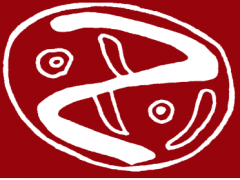Researchers who wish to participate in any of these workshops should submit their abstracts through the WOCAL 10 EasyChair link and they should indicate the workshop code in the “keywords” field. Researchers are encouraged to contact the organisers of the workshops should they have any questions and for further information.
- Centering pragmatic phenomena on the margins in African languages
- Decomposing tones in African languages
- Metaphor in youth language
- The causal-noncausal alternation in African languages
- The impact of non-Bantu languages on Bantu language variation
- African Sign Languages
- Associated motion in African languages
- Let’s turn to policy
- Bantu universals and variation
Centering pragmatic phenomena on the margins in African languages
EasyChair code: PRAG
Organisers: Felix K. Ameka, LUCL & Mark Dingemanse, RU Nijmegen
Contact person: Felix K. Ameka
In Pragmatics, as in Linguistics in general, various expressive devices that are indispensable in communication have been left on the margins as being non-conventional, non-lexical or non-verbal (Bolinger 1946). This includes a range of interjections, particles and conversational gestures (Ameka 1992a; Pillion et al. 2019) but also bodily conduct such as sighs, sniffs, coughs, and winks (Dingemanse 2020b). Despite their ubiquity in everyday interaction, many of these devices are thought of as extra-linguistic or paralinguistic and have consequently been mostly ignored in theoretical and empirical linguistic work. There is a realization on the rise in the language sciences that grappling with these devices holds the key to an understanding of language, the unique feature of the human species.
In this workshop, we invite contributions based on language use, linguistic practices and norms in African communities of practice that investigate the interactional uses of linguistic elements or more broadly semiotic resources that are traditionally thought of as extra-grammatical, non-lexical, or para-linguistic. Examples include:
- Interjections that play roles in human-human and human-animal interactions, e.g calling or sending away various animals (Ameka 1992b; Amha 2013; Bynon 1976; Dingemanse 2020a)
- Conversational routines, including greetings and leave taking expressions (Duranti 1997; Ameka 2009)
- Clicks and other non-lexical vocalisations such as ksss,ʻI want you to pay attention to meʼ, mmm ‘I like this’ etc.; (Painter 1975; Dialo 1985; Gil 2013; Pillion et al. 2019)
- Aspects of bodily conduct that are deployed in interactionally systematic ways, such as sighs, sniffs, laughs, winks, nose wrinkles and facial expressions (Levisen 2019; Dingemanse 2020b)
Researchers wishing to participate in this Panel on Pragmatics should submit abstracts following the abstract submission guidelines for WOCAL10 and include PRAG in the “keywords” field. Abstracts should be submitted via the EasyChair link by November 30th.
The organisers are seeking support to provide bursaries covering travel and accommodation for scholars resident in Africa to be able to participate physically if the situation allows it.
References
Ameka, Felix K. 1992a. Interjections: The Universal Yet Neglected Part of Speech. Journal of Pragmatics 18(2–3). 101–118.
Ameka, Felix K. 1992b. The Meaning of Phatic and Conative Interjections. Journal of Pragmatics 18(2–3). 245–271.
Ameka, Felix K. 2009. Access rituals in West Africa: An ethnopragmatic perspective. In Senft, Gunter & Basso, Ellen (eds.), Ritual Communication, 127–151. Oxford: Berg.
Amha, Azeb. 2013. Directives to Humans and to Domestic Animals: the Imperative and some Interjections in Zargulla. In Simeone-Senelle, Marie-Claude & Vanhove, Martine (eds.), Proceedings of the 5th International conference on Cushitic and Omotic languages. Cologne: Rüdiger Köppe.
Bolinger, Dwight L. 1946. Thoughts on “Yep” and ’Nope. American Speech 21(2). 90–95. (doi:10.2307/486479)
Bynon, James. 1976. Domestic animal calling in a Berber tribe. In McCormack, William & Wurm, Stephen A. (eds.), Language and man: Anthropological issues, 39–65. The Hague: Mouton.
Dialo, Amadou. 1985. Eléments expressifs du wolof contemporain : gestes, signaux oraux, unités significatives nasalisées, interjections, onomatopées, impressifs (Langues Nationales Au Sénégal 27). Dakar: Centre de linguistique appliquée de Dakar.
Dingemanse, Mark. 2020a. Recruiting assistance and collaboration: a West-African corpus study. In Floyd, Simeon & Rossi, Giovanni & Enfield, N. J. (eds.), Getting others to do things: A pragmatic typology of recruitments (Diversity Linguistics). Berlin: Language Science Press.
Dingemanse, Mark. 2020b. Between Sound and Speech: Liminal Signs in Interaction. Research on Language and Social Interaction. Routledge 53(1). 188–196. (doi:10.1080/08351813.2020.1712967)
Duranti, Alessandro. 1997. Universal and Culture-Specific Properties of Greetings. Journal of Linguistic Anthropology 7(1). 63–97.
Gil, David. 2013. Para-Linguistic Usages of Clicks. In Dryer, Matthew S. & Haspelmath, Martin (eds.), The World Atlas of Language Structures Online. Leipzig: Max Planck Institute for Evolutionary Anthropology. (http://wals.info/chapter/142)
Levisen, Carsten. 2019. Laughter Interjections. Scandinavian Studies in Language 10(1). 110–130.
Painter, Colin. 1975. /m hm/, /!m !m/ and Some Forms of Yes and No in Gwa. Anthropological Linguistics. [Anthropological Linguistics, Trustees of Indiana University] 17(1). 19–23.
Pillion, Betsy & Grenoble, Lenore A. & Ngué Um, Emmanuel & Kopper, Sarah. 2019. Verbal gestures in Cameroon. In Clem, Emily & Jenks, Peter & Sande, Hannah (eds.), Theory and description in African Linguistics, 303–322. Berlin: Language Science Press. (doi:10.5281/zenodo.3367128) (Accessed September 18, 2019.)
Decomposing tones in African languages
EasyChair code: TONE
Organisers: Yiya Chen, Leiden University Center for Linguistics (LUCL) & Leiden Institute for Brain and Cognition (LIBC); Laura Downing, Goteborgs University & Netherlands Institute for Advanced Study (NIAS); Annie Rialland, French National Centre for Scientific Research (CNRS).
Contact person: Yiya Chen
There is no doubt that African tone systems have played a significant role in phonological theory (Hyman 2008). What is in stark contrast is how little African languages have figured in our understanding of the phonetic structures of tonal categories and, consequently, the phonetics-phonology interface for tones. What also remains underexplored is how contextual phonetic variation and phonological alternations serve to signal higher-level information, such as cuing sentence structure and encoding information structure (Downing & Rialland 2017 and references therein). Answers to these questions potentially shed light on the deeper and more general issue of speech variation and linguistic representation (Chen 2012).
For this panel, we invite contributions based on experimental data that investigate the phonetic structures of lexical tones and utterance-level tonal variations. The goal of this panel is to bring us closer to understanding the universality and diversity of the forms and functions of speech melody in African tone languages.
Researchers wishing to participate in the Decomposing Tones in African Languages workshop should submit abstracts following the abstract submission guidelines for WOCAL10 and include TONE in the “keywords” field. Abstracts should be submitted via the EasyChair link by November 30th.
References
1. Chen, Yiya. (2012). Message-related variation: Tonal variation. In Cohn, A., Fourgeron, C., and Huffman, M. (eds.), Oxford Handbook of Laboratory Phonology. pp. 103-115. Oxford: Oxford University Press.
2. Downing, Laura & Annie Rialland (2017). Intonation in African Tone Languages. Berlin & Boston: De Gruyter Mouton.
3. Hyman, Larry. (2008). Issues in African Language Phonology. UC Berkeley PhonLab Annual Report 4: 90-109.
Metaphor in youth language
EasyChair code: YOUT
Organisers: Thabo Ditsele, Andrea Hollington, Ellen Hurst-Harosh, Chimwemwe Kamanga, Fridah Kanana, Roland Kouassi, Nico Nassenstein and Sambulo Ndlovu.
Contact person: Thabo Ditsele
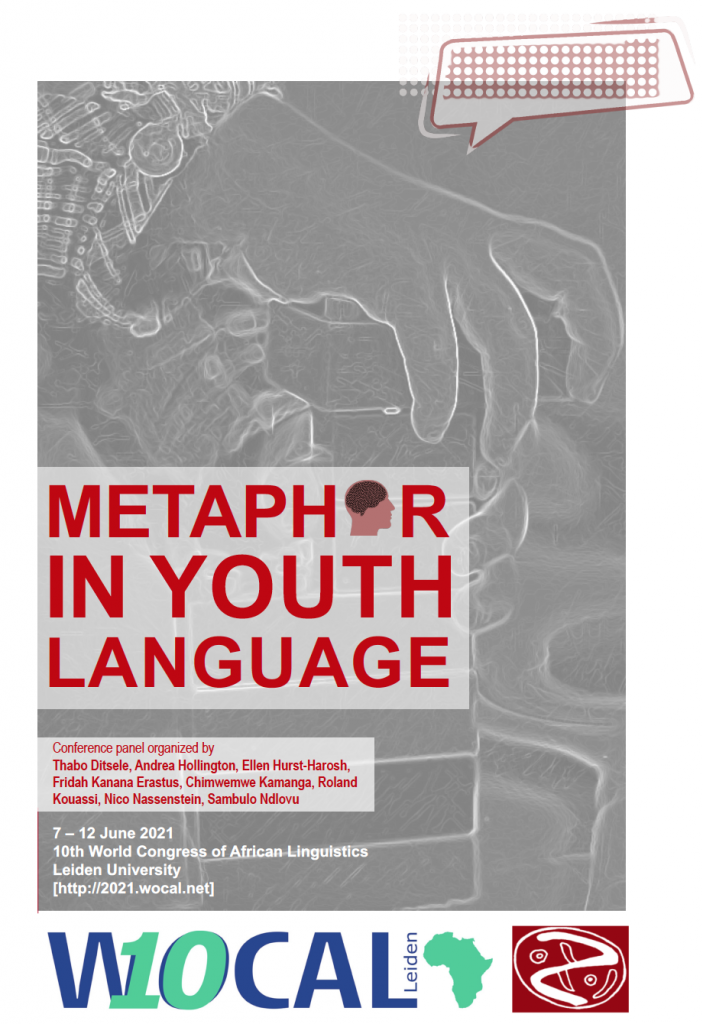
The study of youth language and the linguistic practices of youth in the African continent and in the diaspora is a rich field that has been expanding and deepening in recent years. Linguistic analyses of named ‘urban’ youth varieties such as Sheng in Kenya, tsotsitaals in South Africa, Camfranglais in Cameroon and Nouchi in Côte d’Ivoire constitute a key area of investigation in relation to not only descriptions of grammatical structure and the relation to different types of languages (e.g. local, official, non-official, etc.), but also the investigation of lexical etymologies and manipulation strategies such as metaphor; alongside the role of youth language and its related strategies in social and peer contexts.
There have been several publications that have focused specifically on metaphor in African Youth Language over recent years. These include research employing cognitive metaphor theory (Ndlovu 2018), numerical metaphors in Zimbabwean Computer Mediated Communication (Ndlovu 2020), contribution of youth languages to base language idiomatic language change (Ndlovu 2019), the use of word, sentence, and social metaphor in Tsotsitaal (Hurst 2016), the role of generational peer groups and contemporary pop culture in the production of metaphors (Hurst-Harosh and Kanana 2020), sexual metaphors amongst Nigerian youth (Mensah and Inyabri 2016), and the construction of masculinity through metaphors associated with alcohol consumption (Mensah 2020).
There are numerous opportunities for researchers to build on this work, for example looking at the uses of metaphor in social media and digital communications throughout the African continent, as well as in music (notably hip hop and related forms), performance poetry, film and other creative endeavours (Hurst-Harosh and Kanana 2018,Williams 2017). Interesting questions also arise regarding the use of African languages by youth in the diaspora (Machetti and Siebetcheu 2013, Nassenstein and Tchokothe 2017); as well as global influences on African youth language practices and vice versa (Tomei and Hollington 2020). Questions relating to metaphor would include the analysis of the reciprocal influence of metaphorical linguistic constructions, interpretation / understanding and whether these can be universal. On the other hand, metaphorical processes, and this often becomes obvious in multilingual or language contact situations, are sometimes very culture-specific and can be based on particular socio-cultural conceptualisations (Hollington 2015). Metaphorical constructions relating to gender and sexual orientation from the perspective of feminist theory and LGBTQ linguistics, and the relation of youth language to gender constructions such as masculinity, could be another important avenue for metaphor research in relation to youth. Additionally, important are considerations of the practices of youth in rural and peri-urban settings (Schmied and Oloruntoba-Oju 2019), the cross-dynamics of metaphor drawing on traditional and urban experiences/knowledges, and in addition studies focusing on youth in rural areas who also have notable metaphorical youth language practices (Blench and Longtau 2016).
While it is certain that youth language studies are enriched by investigations into the role of metaphor in youth languages, one question that arises is: Can metaphor studies in turn benefit from a youth language perspective? Theoretical approaches such as cognitive metaphor theory may be enriched and expanded by considering the particular strategies employed by youth, their affordances, their interface with the particular psychological and social concerns of youth, and the apparent creativity of youth in dialogue with popular culture and peer group dynamics.
This workshop therefore invites abstracts from researchers working on any of the following aspects of metaphor in youth language:
- Metaphor and contact, borrowing, etc.
- Globalisation and the impact of international youth forms
- Metaphor and lexical shift
- The linguistics of metaphor in youth language relating to African languages
- The social dynamics of metaphor in youth language relating to African languages
- Identity, social and cultural aspects of metaphor use in youth language (including the politics/ideology of metaphorical constructions in youth language interactions)
- Cultural conceptualisations underlying metaphors in African youth language practices
- Linguistic aspects of the use of metaphors in youth language
- The use of metaphors in social media
- Different methodological and theoretical approaches, including Cognitive Metaphor Theory and others, and new approaches in response to metaphor in youth language
- Gestural metaphor in youth language discourse
References
Blench, Roger& Longtau, Selbut. 2016. Tarok young people speech. Sociolinguistic Studies,10(1&2):219-234.
Ditsele, Thabo& Hurst, Ellen. 2016. Travelling terms and local innovations: The tsotsitaal of the North West province, South Africa. Literator,37(2):1-8.
Hollington, Andrea. 2015. Traveling Conceptualizations. A Cognitive and Anthropological linguistic Study of Jamaican. Amsterdam: Benjamins.
Hurst, Ellen. 2016. Metaphor in South African Tsotsitaal. Sociolinguistic Studies,10(1-2):153–176.
Hurst-Harosh, Ellen. 2020. Tsotsitaalin South Africa: style and metaphor in youth language practices.Cologne: Rüdiger Köppe Verlag.
Hurst-Harosh, Ellen & Kanana, Fridah (eds.) 2018. African Youth Languages: New media, Performing Arts and Sociolinguistic Development. London: Palgrave Macmillan.
Hurst-Harosh, Ellen & Kanana, Fridah. Forthcoming. Metaphors and their link to generation/age and popular culture in African Youth Languages. Linguistics Vanguard.
Machetti, Sabrina. & Siebetcheu, Raymond. 2013. The use of Camfranglaisin the Italian migration context. Tilburg Papers in Culture Studies,Paper 55:1-15.
Mensah, Eyo. & Inyabri, Idom. 2016. The ideological significance of metaphor in sexualized discursive practices among Nigerian youth. Critical Multilingualism Studies,4(2):10-34.
Mensah, Eyo. Forthcoming. He has committed a drinkable offence: The discourse of alcohol consumption among rural youth in Nigeria. Linguistics Vanguard.
Nassenstein, Nico. & Tchokothe, Remi. 2017. From home to home: African youth languages in the diaspora. In: Shigeki Kaji (ed.), Proceedings of the 8th World Congress of African Linguistics. Tokyo: Research Institute for Languages and Cultures of Asia and Africa (ILCAA): 313-329.
Ndlovu, Sambulo. 2010. Aspects of Ndebele idiomatic language change. Zimbabwe International Journal of Language and Culture,1(2):77-87.
Ndlovu, Sambulo. 2018. A Comparative analysis of metaphorical expressions used by rural and urban Ndebele speakers: The contribution of S’ncamtho. PhD Thesis, University of Cape Town.
Ndlovu, Sambulo. 2019. The S’ncamtho contribution to Ndebele idiomatic language change. In: Atindogbé, Gratien& Ebongue, Augustin. (eds.), Linguistic and Sociolinguistic Perspectives of Youth Language Practices in Africa: Codes and Identity Writings. Bamenda: Langaa: 165-180.
Ndlovu, Sambulo. Forthcoming. Attributional and relational influence of numerals in S’ncamtho metaphors. Linguistics Vanguard.
Schmied, Josef& Oloruntoba-Oju, Taiwo. (eds). 2019. African urban and youth languages: The rural-urban divide. Göttingen: Cuvillier.
Tomei, Renato. & Hollington, Andrea. Forthcoming. Transatlantic linguistic ties: The impact of Jamaican on African youth language practices. Linguistics Vanguard.
Williams, Quentin. 2017. Remix Multilingualism: Hip Hop, ethnography and performing marginalized voices. London: Bloomsburg.
The causal-noncausal alternation in African languages
EasyChair code: CAUS
Organisers: Sebastian Dom, University of Gothenburg; Leora Bar-el, University of Montana; Ponsiano Kanijo, Mkwawa University College of Education; Malin Petzell, University of Gothenburg.
Contact person: Sebastian Dom
This workshop aims to bring together a collection of papers on the causal-noncausal alternation from a wide range of African languages. The valency alternation, illustrated with an example from Wanin(1), has received little systematic and comparative attention in languages from across the African continent.
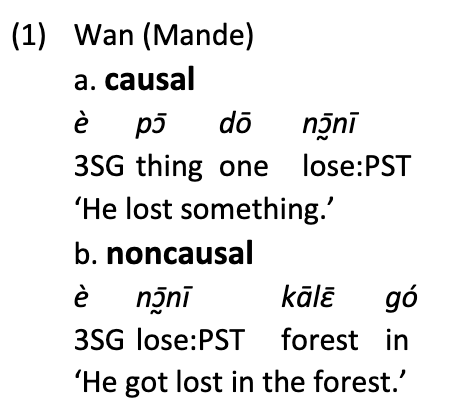
‘Causal’ and ‘noncausal’ are semantic notions that refer to related events differentiated by the number and typeof participant roles; a causal event involves an external and internal participant role while a noncausal event only includes an internal participant role. For the verb pair lose/get lost in (1) both the causal and the noncausal events involve a theme-like participant, whereas only the causal event includes an agent-like event-external participant. The valency alternation lies at the interface between semantics, morphology and syntax, and has been the focus of different theoretical approaches (e.g., Härtl 2003, Alexiadou and Anagnostopoulou 2004, Koontz-Garboden 2005, Schäfer 2009, Haspelmath et al. 2014, Haspelmath 2016, Schäfer and Vivanco 2016). Typological-comparative studies such as Haspelmath (1993: 90-92) and Nichols et al. (2004: 158-160) have identified various types of formal relationships between causal and noncausal verbs in the languages of the world:
- Causative strategy: the verb denoting the causal event is formally derived from the verb denoting the noncausal event.
- Anticausative strategy: the verb denoting the noncausal event is formally derived from the verb denoting the causal event.
- Equipollent strategy: both verbs are formally derived from a shared root.
- Labile strategy: the same verb is used to denote the causal and noncausal event.
- Conjugation class change strategy: both verbs are underived but take a different conjugation class.
- Auxiliary change strategy: phrasal predicates using different auxiliaries or light verbs within the same verb root or heavy verb.
- Adjectival strategy: the causal event is denoted by a verb and the noncausal event is denoted by an adjective.
- Ablaut strategy: Difference of vowel or consonant grade in root or stem, but no difference in formal morphological composition.
- Suppletion strategy: The causal and noncausal events are denoted by two lexically different verbs which are not related by any direct morphological process.
In a sample of 30 languages from sub-Sahara Africa, Creissels (2018) compares the morphological alternations for 13 causal-noncausal pairs restricted to inanimate undergoers. He observes that most languages have one “relatively prominent strategy”. Interestingly, 10 out of the 30 sub-Saharan languages have lability as the most prominent formal relationship between causal-noncausal verb pairs with inanimate undergoers. This is in stark contrast with Haspelmath’s (1993)mainly Eurasian sample, where English is the only language that has a high prominence of lability for causal-noncausal verb pairs. This begs further investigation: Is the labile strategy determined by areal typology, or because of the semantic restrictions of Creissels’ verb list, i.e. inanimate undergoers only? Creissels (2018: 6) also observes that the anticausative strategy is particularly prominent in languages with a high degree of morphological complexity, whereas languages which lack anticausative derivation are morphologically simple. There are three exceptions, namely Fula, Herero and Hausa, all of which are morphologically complex but demonstrate a high proportion of equipollent pairs instead of anticausatives. Again, the tendency needs to be corroborated with more data from a more diverse range of African languages. Finally, it stands out from Creissels (2018) that causativization is not a highly prominent strategy in any of the sample’s languages. As pointed out by Creissels (2018: 7), this could be related to the fact that causitivization is not as productive with events involving inanimate undergoers but instead is more productive with other types of causal-noncausal pairs. This hypothesis should be further investigated by looking at those causal-noncausal verb pairs with animate undergoers in African languages.
Although lability together with anticausativity form the main strategies encountered in Creissels’ language sample, his study also illustrates that variation abounds in African languages. With the exception of Creissels (2018), data on the causal-noncausal alternation in African languages is extremely fragmented. In order to identify finer-grained typologies and detailed comparative studies, we need more parallel data from a wide range of different languages.
The workshop intends to address this research agenda by inviting scholars to present papers on the causal-noncausal valency alternation in African languages, preferably but not necessarily based on Haspelmath’s (1993)31 verb pairs, given in (2) below.

Notwithstanding possible methodological issues with some verb meanings (e.g. develop, dissolve or freeze), the wordlist forms a good basis for cross-linguistic comparison. This is evinced by the World Atlas of Transitivity Pairs, an online database including data from 80 languages of which only 7 are from Africa, namely Amharic, Herero, Kupsapiny, Matengo, Sidaama, Swahili and Wolaytta.
We are particularly interested in papers that deal with the following topics:
- Language-individual analyses of the formal relationship(s) between causal and noncausal verbs. Are there one or more strategies, and is there a predominant one? How does this relate with the relative degree of morphological complexity of the language? How do the strategies relate to the coding of other valency alternations such as the causative, passive, reflexive, etc.? For example, in Mano(Mande) two different strategies are used for noncausal events, lability or reflexivization (Vydrin and Khachaturyan 2015). The labile strategy is also used for passive constructions. These polysemous strategies are illustrated in example (3).
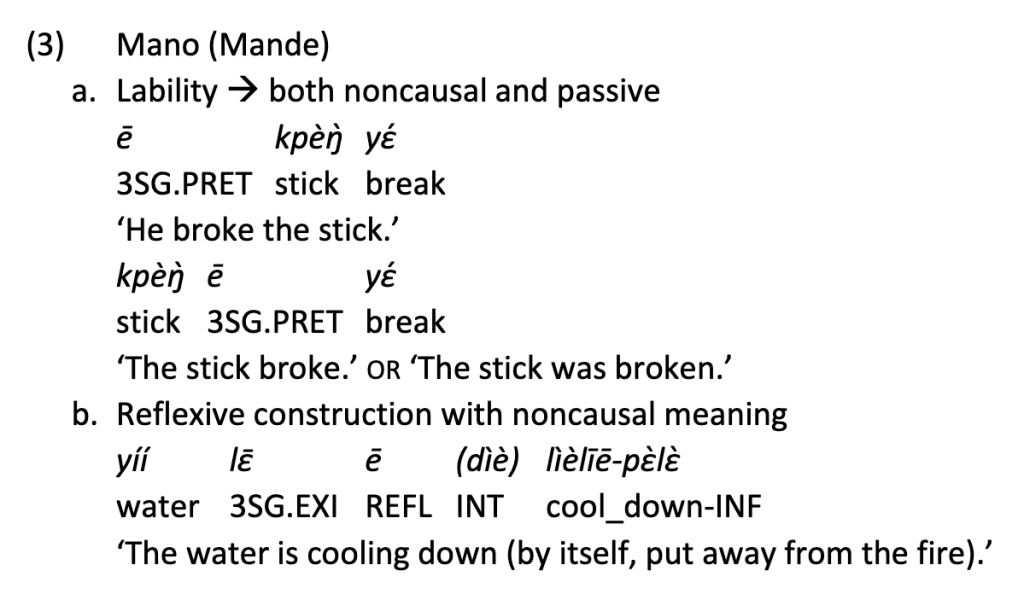
- Wide-or small-scaled comparative studies on the formal relationship(s) between causal and noncausal verbs. Observations from Creissels’ (2018) 13-verb study can be tested a) on the basis of Haspelmath’s (1993) full verb list including events with animate undergoers and b) in languages not included in Creissels’ sub-Saharan sample (see some points of interest in the discussion of Creissels 2018 above).
- Discussion of methodological issues and the lexicalization of the verb meanings in particular languages. For example, Creissels (2018: 10) notes that the meanings GO OUT/PUT OUT (A FIRE) are frequently expressed by the same predicates denoting the meanings DIE/KILL in sub-Saharan languages, e.g. buu/wii in Koroboro Senni (Songhay). In Ibibio, there are two different BREAK verbs, i.e. bòm and bʌ́nas illustrated in (4).
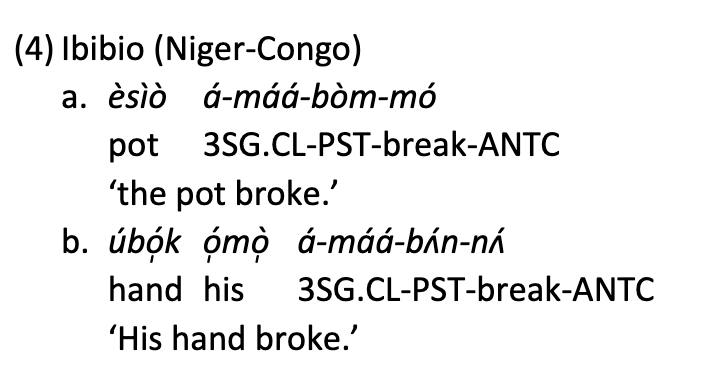
- Detailed studies on the transitivity and syntax of causal/noncausal events. What are the argument structure constructions or (coding) frames of the verbs denoting causal/noncausal events in individual languages, and how might they differ from one another between languages? How is the mapping of semantic roles onto syntactic arguments reconfigured between constructions used for causal versus noncausal events?
References
Alexiadou, Artemis & Anagnostopoulou, Elena. 2004. Voice morphology in the causative-inchoative alternation: Evidence for a non-unified structural analysis of unaccusatives. In Alexiadou, Artemis & Anagnostopoulou, Artemis & Everaert, Martin (eds), The unaccusativity puzzle: Explorations of the syntax-lexicon interface, 114-136. Oxford: Oxford University Press.
Anyanwu, Ogbonna. 2013. Ibibio causative and anti-causative verb alternations. In O̩la Orie, O̩lanike & Sanders, Karen W. (eds), Selected Proceedings of the 43rd Annual Conference on African Linguistics, 106-114. Sommerville, MA: Cascadilla Proceedings Project.
Creissels, Denis. 2018. The noncausal-causal alternation in the languages of Subsaharan Africa: A preliminary survey of noncausal-causal pairs involving inanimate undergoers. (Paper presented at the 51st Annual Meeting of the Societas Linguistica Europaea, Tallin, 29 August -1 September 2018.) (Accessed 10/07/2020.)
Härtl, Holden. 2003. Conceptual and grammatical characteristics of argument alternations: The case of decausative verbs. Linguistics41(5). 883-916.
Haspelmath, Martin. 1993. More on the typology of inchoative/causative verb alternations. In Comrie, Bernard & Polinsky, Maria (eds), Causatives and transitivity, 87-120. Amsterdam: John Benjamins.
Haspelmath, Martin. 2016. Universals of causative and anticausativeverb formation and the spontaneity scale. Lingua Posnaniensis 58(2). 33-63.
Haspelmath, Martin & Calude, Andreea S. & Spagnol, Michael & Narrog, Heiko & Bamyaci, Elif. 2014. Coding causal-noncausal verb alternations: A form-frequency correspondence explanation. Journal of Linguistics50(3). 587-625.
Koontz-Garboden, Andrew. 2005. On the typology of state/change of state alternations. Yearbook of Morphology. 83-117.
Nichols, Johanna & Peterson, David A. & Barnes, Jonathan. 2004. Transitivizing and detransitivizing languages. Linguistic Typology8. 149-211.
Nikitina, Tatiana. 2014 [2018]. Transitivity in Wan. In Anyanwu, Rose-Juliet (ed.), Transitivity in African languages(Frankfurter Afrikanistische Blätter 26), 107-124. Cologne: Rüdiger Köppe.
Schäfer, Florian. 2009. The causative alternation. Language and Linguistics Compass3(2). 641-681.
Schäfer, Florian & Vivanco, Margot. 2016. Anticausatives are weak scalar expressions, not reflexive expressions. Glossa: A Journal of general linguistics1(1). 18. 11-36.
Vydrin, Alexandra & Khachaturyan, Maria. 2015. Morphological effects of agent-oriented components of verbal semantics. (Paper presented at the 11th Conference of the Association for Linguistic Typology, Albuquerque, 02/08/2015.)
The impact of non-Bantu languages on Bantu language variation
EasyChair code: CONT
Organisers: Hilde Gunnink, Ghent University / BantUGent – UGent Centre for Bantu Studies; Koen Bostoen, Ghent University / BantUGent – UGent Centre for Bantu Studies; Tom Güldemann, Humboldt University Berlin and MPI-SHH Jena.
Contact person: Hilde Gunnink
The spread of Bantu speech communities from their homeland in the borderland between Nigeria and Cameroon towards Eastern and Southern Africa beginning ~4000 years ago had a significant influence on the continent’s linguistic, demographic and cultural landscape. The Bantu Expansion led to the disappearance of many pre-existing languages and speech communities. Speakers of autochthonous languages regularly shifted to those of migrating Bantu speakers by whose societies they often got absorbed. In some areas this shift is historically attested or even ongoing, for instance in certain parts of Southern Africa; in others, such prehistoric language shift can only be deduced from the traces it left in the surviving Bantu languages, as has been hypothesized for certain West-Coastal Bantu languages. Interdisciplinary approaches, combining linguistic data with insights from archaeology, anthropology and human genetics, have greatly improved the likelihood of understanding this prehistoric language contact.
The goal of this workshop is to identify linguistic traces left in Bantu languages from non-Bantu languages, and discuss their implications for our understanding of how these different communities interacted in the past. We welcome contributions on any Bantu language or subgroup of languages. Our focus is on language contact in the (distant) past, but we also welcome studies of ongoing language contact situations in as far as these can be used as a point of comparison for language contact with a larger time depth. Interdisciplinary studies combining linguistics with other relevant scientific disciplines are also strongly encouraged.
Associated motion in African languages
EasyChair code: ASMO
Organisers: Roland Kießling, University of Hamburg; Bastian Persohn, University of Hamburg; Daniel Ross, University of Illinois, UC Riverside.
Contact person: Bastian Persohn
The grammatical category of associated motion (AM) is constituted by markers related to the verb that encode translational motion (e.g. Koch 1984; Guillaume 2016). (1–3) illustrate AM markers in African languages.
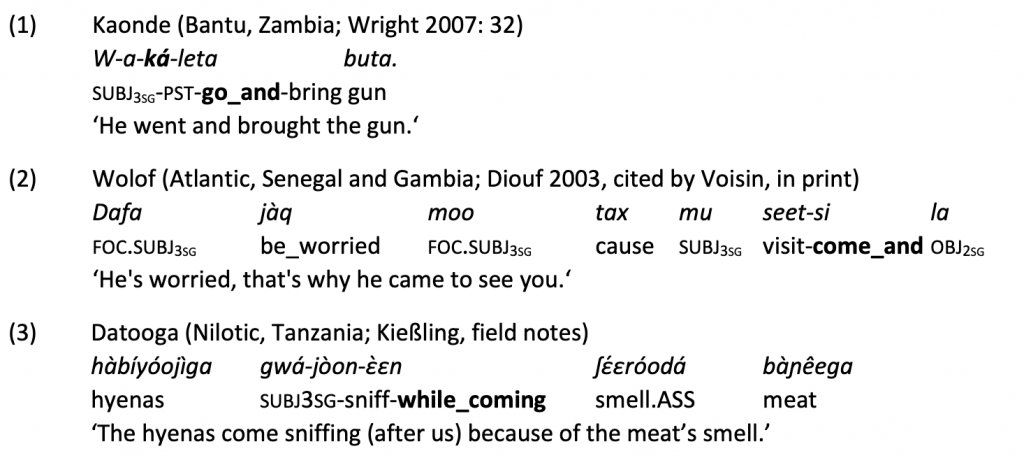
Associated motion markers are a common device in African languages, as evidenced in Belkadi’s (2016) ground-laying work, in Ross’s (in press) global sample as well as by the available surveys of Atlantic (Voisin, in press), Bantu (Guérois et al., in press), and Nilotic (Payne, in press). In descriptive works, AM markers are often referred to by other labels, such as movement grams, distal aspects, directional markers, or itive/ventive markers.
Typologically, AM systems may vary with respect to the following parameters (e.g. Guillaume 2016):
- Complexity: How many dedicated AM markers do actually contrast?
- Moving argument: Which is the moving entity (S/A vs. P argument)
- Conflation with path parameters: Is the motion directed and if so, in which direction (e.g. ‘go’ vs. ‘come’)?
- Temporal relation between the core event and the motion co-event: Does the motion co-event occur prior to the core event (‘do then move’), is it subsequent (‘move then do’) or do both events occur concurrently (‘do while moving’)?
- Conflation with additional parameters such as aspect or transitivity.
African languages are of particular importance for understanding the typology of the category of associated motion because they differ from other AM hotspots such as Australia and South America in several of these parameters: their systems tend to be pardigmatically less complex, yet there is a higher frequency of subsequent markers, including non-subject motion (Belkadi 2016, Ross, in press). Furthermore, AM markers in African languages are frequently multi-functional, overlapping with categories such as direction (Belkadi 2016) or static locational deixis (Creissels and Bassène, in press; Guerois et al., in press; Voisin, in press). In some Nilotic languages, AM markers have secondary functions that relate to argument structure configurations. For instance, in Datooga, there is a tendency for transitive verbs such as duul-d ‘take away in entirety’ to be reduced to intransitives by deletion of an external patient role in the course of AM derivation, resulting in duul-ɛɛd ‘move thither in a group’.
Despite recent advances in the study of AM systems in individual languages on the one hand as well as in fleshing out typological generalisations on AM as a grammatical category on the other hand, detailed descriptions of individual AM systems in African languages remain rare. And while for many Bantu languages AM markers have been traced back to motion verbs (Guérois et al, in press), the etymology of such forms in many other African languages remains obscure. Another relevant comparison is to multi-verb constructions: for example, serial verb constructions (SVCs) often have similar semantic functions (Lovestrand and Ross, in press) and are one diachronic source for AM markers. Consider (4) from Akan, where motion verbs ‘go’ and ‘come’ have developed into AM prefixes, originally from SVCs, but may now also co-occur within SVCs with lexical motion verbs.

We therefore invite contributions on all aspects of AM in African languages, especially (but not limited to):
- Synchronic descriptions of AM systems in individual languages or (areal or genetic) groups
- Historical reconstructions of individual AM markers and systems
- The relationship between multi-verb or other syntactic constructions and AM morphology
- Studies addressing the overlap with other functional categories
- Discourse functions of AM systems, e.g. in spatial organisation of plot development in narratives
References
Belkadi, Aïcha. 2016. Associated motion constructions in African languages. Africana Linguistica 22. 43–70.
Creissels, Denis & Alain Christian Bassène, In press. Ventive, associated motion and aspect in Jóola Fóoñi (Atlantic). In Guillaume & Koch (eds.).
Guérois, Rozenn, Hannah Gibson & Bastian Persohn. In press. Associated motion in Bantu languages. In Guillaume & Koch (eds.). In Antoine Guillaume & Harold Koch (eds.).
Guillaume, Antoine. 2016. Associated motion in South America: Typological and areal perspectives. Linguistic Typology 20 (1). 81–177.
Guillaume, Antoine & Harold Koch (eds.). In press. Associated Motion. Berlin: Mouton de Gruyter.
Koch, Harold. 1984. The category of “associated motion” in Kaytej. Language in Central Australia 1. 23–34.
Lovestrand, Joseph & Daniel Ross. In press. Serial verb constructions and motion semantics. In Guillaume & Koch (eds.).
Osam, E. Kweku. 2002. The ingressive in Akan: a reconsideration. In Felix K. Ameka & E. Kweku Osam (eds.), New Directions in Ghanaian Linguistics, 113–126. Accra: Black Mask Ltd.
Ross, Daniel. In print. A cross-linguistic survey of associated motion and directionals. In Guillaume & Koch (eds.).
Voisin, Sylvie. In print. Associated motion and deictic directionals in Atlantic languages. In Guillaume & Koch (eds.).
Wright, John Lisle. 2007. An outline of Kikaonde grammar. Lusaka: Bookworld Publishers & UNZA Press.
Let’s turn to policy
EasyChair code: POLI
Organisers: This workshop will be facilitated by the Edinburgh Circle on the Promotion of African Languages, Elise Bagamboula, Ann Hildah Gataaka, Taiwo Oloruntoba-Oju and Bert van Pinxteren.
Contact person: Bert van Pinxteren
The WOCAL CfP states: ʻOnly by using African languages in all spheres of social life in African societies does communication become inclusive and information truly accessible to all and lead to reducing inequality and establishing sustainable societies.ʼ Clearly, this calls for policies that can bring about a transition to such inclusive and sustainable societies, policies that are informed by relevant linguistic knowledge.
The workshop aims to bring together a number of presentations that address issues of language planning, design and policy (in education as well as in other domains) in Africa, using a linguistic perspective but open to interdisciplinary approaches. Proposals are invited that examine issues such as what inclusive language policies should look like in practice, the choice(s) for national or working languages, what advice to give on national educational strategies from a linguistic perspective, how to plan for and implement changes in language use, how to ʻintellectualizeʼ African languages for use in various formal domains, how to work in a participatory rather than a top-down manner, and what a socially relevant linguistic research agenda should look like in view of current policy challenges. Proposals that address specific countries are welcome, as well as proposals that look at African languages more in general.
Researchers wishing to participate in the workshop should submit their abstracts following the abstract submission guidelines for WOCAL10 and include POLI in the “keywords” field. Abstracts should be submitted via the EasyChair link by November 30th.
Bantu universals and variation
EasyChair code: BANT
Organisers: BaSIS team Leiden (Jenneke van der Wal, Elisabeth Kerr, Zhen Li)
Contact person: Jenneke van der Wal
“[W]ork on African languages has reached the critical mass necessary to make insightful comparative work between African languages possible. I think this is especially true of the Bantu languages, for perhaps no other language family possesses so many distinct languages that have so much in common syntactically.” (Henderson 2011:23)
As the field of Bantu typology is gaining momentum, we are organising a workshop with the aim to obtain a picture of the synchronic variation within the Bantu language family. We aim to go beyond lexical data to consider morphosyntax, phonology, and semantics, and welcome presentations from any framework.
Topics to be discussed include, but are not limited to:
- Typological generalisations. Which gaps and patterns have been encountered? Which implicational relations exist between formal properties of Bantu languages? For example, Marten and Van der Wal (2014) show that all languages that have instrument inversion also have locative inversion, Van der Wal (2020) shows a relation between multiple object markers and object symmetry, and Hyman (2007) claims that tone anticipation is always associated with right edge factors.
- Explanations. How can parameters (e.g. Marten et al. 2007) explain the generalisations found? Where and to what extent do we see the influence of areal contact? How does Bantu behave in comparison to universals find across the world? For example, recent work compares Greenberg’s Universal 20 patterns in Bantu languages with other language families (e.g. Carstens 2008, Muriungi 2009; Cinque 2005), Downing (2003) shows how the almost-absence of tonal transfer in reduplication follows if reduplication is seen as compounding, there is the ongoing debate on H vs. L tones or H vs. Ø (e.g. Marlo & Odden 2019), Van de Velde (2019) explains how the unexpected variation in nominal word order can be understood by the Adnominal Modifier Apposition & Reintegration mechanism, and Good (2016) proposes templates to account for word and morpheme order.
- Methodology. Looking beyond one or two languages to universals and variation across a language family poses many methodological questions. Which software can be used for storing Bantu typological-comparative data? Is there now enough descriptive material for meaningful quantitative analyses (cf. Nurse & Philippson 2003)? How do we decide on sample size (e.g. Nurse 2008)? Previous projects have used map tools (e.g. SOAS Bantu Project 2014-2018) and phylogenetic methods are becoming popular alternatives to earlier lexicostatic methods (Marten 2020; Grollemund et al. 2015).
- Micro- vs. macrovariation. The Bantu area has been characterised as a convergence zone (Marten 2013) with an overall high degree of morphosyntactic similarity – yet there is a lot of microvariation. Are there different types of generalisations within subgroups from those at the pan-Bantu level? What do these universals and variation tell us about the ‘spirit’ of the family (Sapir 1921, Baker 2008)? While we do not want to focus on reconstruction and classification issues, the synchronic picture may reveal different types of variation on the micro vs. macro level.
The invited speaker for this workshop is Daisuke Shinagawa, Associate Professor at the Research Institute for Languages and Cultures of Asia and Africa, Tokyo University of Foreign Studies, Japan.
For this workshop, we invite abstracts from scholars working on any of the above issues in any theoretical framework. Abstracts should be max. 2 pages A4 font size 12pt including examples and references. Please submit your abstract through EasyChair, indicating BANT in the ‘Keywords’ field to indicate that the abstract is intended for this workshop.
References
Baker, M. 2008. The syntax of agreement and concord. Cambridge: Cambridge University Press.
Carstens, V. 2008. DP in Bantu and Romance, in C. de Cat & K. Demuth (eds), The Bantu- Romance connection, John Benjamins, Amsterdam/Philadelphia
Cinque, G. 2005. Deriving Greenberg’s Universal 20 and its exceptions. Linguistic inquiry, 36(3), 315-332.
Downing, L. J. 2003. Compounding and tonal transfer in Bantu languages. Phonology 20. 1-42.
Good, J. 2016. The linguistic typology of templates. Cambridge: CUP.
Grollemund, R., Branford, S., Bostoen, K., Meade, A., Venditti, C., and Pagel, M. 2015. ‘Bantu expansion shows habitat alters the route and pace of human dispersals’, Proceed ings of the National Academy of Sciences 112(43) 13296–301. doi.org/10.1073/pnas. 1503793112
Grollemund, R. 2012. Nouvelles approches en classification: Application aux langues bantu du Nord-Ouest. Doctoral dissertation, Université Lumiere Lyon, 2.
Henderson, B. 2011. African languages and syntactic theory: Impacts and directions. In Eyamba G. Bokamba et al. (eds), Selected proceedings of the 40th annual conference on African linguistics, 15–25. Somerville, MA: Cascadilla Proceedings Project.
Hyman, L. M. 2007. Universals of tone rules: 30 years later. In T. Riad & C. Gussenhoven (eds), Tones and Tunes: Studies in Word and Sentence Prosody, 1-34. Berlin: Mouton de Gruyter.
Marlo, M. R. and D. Odden. 2019. Tone. In Van de Velde et al. (eds.), The Bantu languages, second edition, 150-171. London: Routledge.
Marten, L., Kula, N. C., and Thwala, N. 2007. ‘Parameters of morphosyntactic variation in Bantu’, Transactions of the Philological Society 105: 253–338.
Marten, L. 2013. Linguistic variation, language contact and the new comparative Bantu. Inaugural Lecture, SOAS, University of London, 18 April 2013.
Marten, L and van der Wal, J. 2014. A typology of Bantu subject inversion. Linguistic variation Vol. 14, 2.
Marten, L. 2020. Bantu and Bantoid. In The Oxford Handbook of African Languages.
Muriungi, P. K. 2009. Phrasal movement inside Bantu verbs: Deriving affix scope and order in Kîîtharaka. Doctoral dissertation, University of Tromsø.
Nurse, D, and Gérard P. 2003. Towards a historical classification of the Bantu languages. In The Bantu languages. Derek Nurse and Gérard Philippson, eds. Pp. 164–181. London: Routledge.
Sapir, E. 1921. Language: An Introduction to the Study of Speech. New York, NY: Harcourt, Brace, and Company.
Nurse, D. 2008. Tense and Aspect in Bantu. New York: Oxford University Press.
Van de Velde, Mark O. 2019. Les expressions nominales dans les langues bantu. Mémoire d’habilitation, LLACAN-CNRS.
Van der Wal, J. 2020. The AWSOM correlation in comparative Bantu object marking. In Katharina Hartmann, Johannes Mursell, and Peter W. Smith (eds.), Agree to agree: Agreement in the Minimalist Program, 199-234. Open Generative Syntax, Language Science Press.
